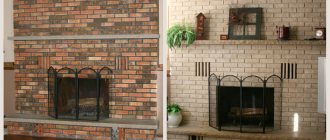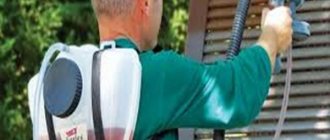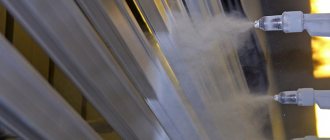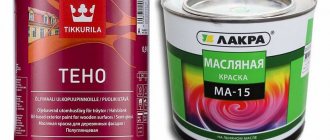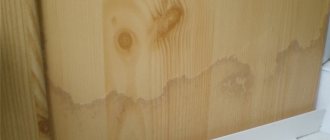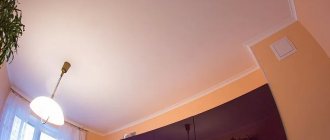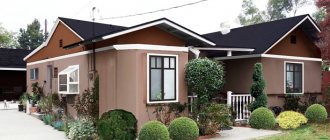Advantages of designs
By choosing a concrete fence, the consumer gains a number of potential advantages:
- aesthetic appearance - the owner’s preferences are easily expressed in form;
- affordable price range is a distinctive feature that does not affect quality;
- quick installation – depending on the length, professional installation is carried out within 24 hours.
Proper operation will ensure long-term service and reliability.
Why do you need to paint a concrete fence?
Concrete is a durable material, but due to its porous structure it is susceptible to external influences and natural phenomena.
During precipitation, moisture penetrates and accumulates in the depths of the structure. Low temperatures change the physical properties of water - they expand the volume. Periodic freezing and thawing significantly reduces the strength of concrete .
Places where liquid accumulates are a favorite habitat for mold spores and spore-bearing plants - mosses, lichens, fungi. Actively multiplying, unsightly spots disfigure the appearance of the fence.
Without a protective coating, a concrete fence loses its appearance and strength. Source fizzano.com
The proximity of industrial enterprises and highways has a detrimental effect on the fence. Aggressive toxic elements released into the atmosphere trigger destructive processes, even in stone.
All this leads to the formation of cracks and chips on the untreated surface. Painting the concrete fence will prevent disastrous consequences. In addition, a correctly selected color scheme will harmoniously fit the design into the overall style of the house building and the plot.
The psychological aspect is important. By surrounding oneself with gray color, a person at a subconscious level is deprived of bright positive emotions. Adding color to everyday life is an extra chance to get away from depression. After all, the visual perception of light turns into tactile sensations.
A product for cleaning concrete from mold and spore plants Source lingot.kiev.ua
See also: Catalog of companies that specialize in paints and varnishes.
Determination of painting method, pattern
Options for painting a gray concrete fence can be:
- solid - when the entire structure is given one color;
- segmental - when the main components of the fence are painted in distinctive colors;
- artistic - for example, painting to resemble stone or wood.
Recommendation: the optimal color scheme for the fence is to match the roof of the house located on the site. Sometimes the tone of the barrier is determined by its texture (stone, brickwork).
Preparatory stage
Consultation with a competent specialist will help you determine how to paint a concrete fence, the amount of material needed, its quality characteristics and the sequence of work.
The initial stage - primer, is carried out to ensure reliable adhesion between the layers of paint and the upper exterior of the fence. In addition, pre-treatment helps improve the absorbency of concrete .
First of all, the surface is cleaned of accumulated contaminants. Concrete elements are covered with a soap solution and after a certain period of time they are cleaned with a stiff brush. If the fence has already been painted, the dilapidated coating is removed with special removers.
The sections are then washed with clean water and dried thoroughly. The metal parts of the structure are sanded and lubricated with a high-quality anti-corrosion agent. Cracks and chips are repaired with cement-sand mortar. When subsequently using paints with increased vapor permeability, the surface is covered with a waterproofing mixture. After restoration work, time is allowed for repeated drying.
Sealing cracks and preparing the concrete surface before painting Source mastersaite.ru
Moving directly to the priming process, consider the following details:
- when choosing paints and primers, priority is given to one manufacturer;
- water-based pre-treatment composition is applicable only to previously unpainted surfaces;
- organic primer is intended for products made of low-grade concrete;
- both sides of concrete sections are treated with the composition;
- For faster application, rollers are used; hard-to-reach areas are treated with a brush.
Depending on the soil, subsequent drying takes from 12 hours to a day. Organic compounds are not afraid of low temperatures. Polyurethane mixture is an exception, but the effectiveness of its protective properties is beyond praise. The water base of the starting layer “prefers” increased atmospheric humidity.
Preparation
Before the main stage of work, a set of equally important preparatory measures is carried out. For greater effect on concrete protection, fences should not be painted immediately after installation - the waiting time is 1 year. During this period, the structure will “take its place”, and damaged and defective areas will appear on the fencing elements.
Using a hose and water, the structure can be wetted for further cleaning of dirt.
Sometimes trees, shrubs, flowers, and benches grow close to the concrete fence. Objects that will be “in the affected area” during work are covered with film. When the fence was uncoated, it managed to become contaminated with dust, soil particles, and bird droppings. In this case, dry cleaning of the blocks is not enough. Concrete surfaces are watered with water from a hose, then left for 20 minutes, after which dirt is removed with a brush. If possible, use a special detergent. Then the dirt is washed off with water under pressure.
If the sections were previously painted or they are glossy, then to ensure good adhesion of the new layer of protection to the base, the concrete is treated using a sandblasting machine. It will make the area relief, which will ensure the durability of the fresh coating. When traces of organic matter appear on the structure - mold, moss, fungi, lichens - they are removed and then treated with a protective substance.
The finish of the preparatory work is the application of a primer.
The last preparatory stage is priming. This mixture strengthens the internal structure of concrete, smoothes its surface and improves the adhesion of the base to the protective layer. The substance is applied at a temperature above +5 degrees evenly to work areas with a fleecy roller, in hard-to-reach places - with a brush. The solution dries in 24 hours.
Selection of paints and varnishes
When choosing materials, fundamental importance is attached to their characteristic features. In order not to get confused in the wide range of paints for concrete fences, you should understand their inherent properties.
- Silicate . Vapor-permeable paint is based on liquid glass. It has good contact with the surface, has unusual water resistance, prevents the formation of fungi and mold, and is not susceptible to aggressive chemicals.
- Water-based . Contains polymer particles and pigments. Advantages: reasonable cost, variety of color shades, the mixture dries quickly without cracking. Disadvantages - susceptibility to temperature fluctuations, humidity, damage.
- Acrylic . A classic version of water-dispersion paint. When dried, it loses its properties - dissolving in liquids. Resistant to sunlight and moisture, and is highly environmentally friendly. When choosing a color, take into account slight darkening after application.
Technology of applying paint to the surface of concrete using a spray gun Source arka-green.ru
- Latex . Chemical base – acrylic copolymer. It is not durable, but latex gives the paint material a different glossy finish. A characteristic feature allows you to create a brilliant reflective effect.
- Rubber . The uniqueness of concrete paint is its ability to change physical properties with temperature changes. The elasticity of the material ensures heat resistance, waterproofing capabilities, and resistance to the influence of negative factors.
- Oily . The coating protects the painted surface from external influences, the colonization of microorganisms, the accumulation of dirt, and vapor permeability. The weak link is a short service life, rapid fading.
When purchasing a painting material, you should make sure that it is intended for outdoor use. An essential detail - matte paint masks small defects well, while gloss emphasizes it.
Painting concrete with acrylic paint using a brush Source radiomoon.ru
Color solution
Color preferences are the prerogative of the buyer. If it is difficult to make a choice, you can try the computer option for selecting color paints and their harmonious combination.
Design solutions are based on simple principles:
- rule of 3 colors - a significant part of the main color, complemented by a compatible color shade and 10% of the accent color;
- exclusion of variegated flashy colors in a joint composition - pretentiousness does not attract, but repels;
- the use of colorless dyes only on surfaces that do not have flaws;
- white shades combine well with the main color palette;
- imitation of natural materials is produced in colors close to the original;
- a hedge in green shades is a wonderful backdrop if there are a large number of flowering ornamental plants on the plot;
- the roof matched to the façade of the house is harmoniously combined, and the color of the fence matches the roof ;
- the fence of a small courtyard in light colors - this will not visually narrow the small space;
- if the size of the personal plot differs in scale, they prefer dark shades - a visual guarantee of security ;
- with the plastered gray facade of the house building, attention is focused on bright colors.
Concrete fence in dark shades using patina Source pnx.com.ua
Whatever shade you choose, the main thing to remember is that color attracts the eye, gives rise to emotions and conveys meaning.
When purchasing painting material, it is necessary to ensure that all containers belong to the same batch. Otherwise, there is a chance to purchase different shades. If the color scheme involves a tinting procedure, all manipulations are performed at the place of purchase.
Application technology
The main work is carried out in sunny, windless weather with minimal humidity. In order to have enough time for painting and drying, it is better to check the atmospheric forecast.
During precipitation, the protective layer will lose its quality benefits, and strong gusts of wind will contaminate the surface.
The choice of how to paint a concrete fence depends on the surface topography. The ideal application option is to use a spray gun and professional equipment .
To create a uniform color shade, the coloring matter is thoroughly mixed. Corners and hard-to-reach areas are worked with a brush, while drips are prevented by evenly distributing the composition.
To imitate a stone pattern, an important point is the correct marking. Source 1beton.info
To prevent contamination of the lower part of the structure, the upper sections are painted first. For smoothed surfaces, using a roller is acceptable. When processing the base, make sure that the paint completely fills the concrete pores.
After the primary layer has dried, the fence is re-painted using a spray gun. In most cases, a double layer provides rich shade and deep coloring. However, the number of repeated applications depends on the whim and preferences of the owner.
Nuances of painting imitation
An imitation of natural stone will help add uniqueness to a flat concrete area. The step-by-step procedure looks like this:
- the fence is covered with a base layer and left to dry;
- Mark the base with a pencil and a construction ruler in accordance with the dimensions of the simulated materials;
- apply masking tape over the selected markings ;
- the open area is painted with the shade chosen for imitation;
- After the next drying, the tape is removed .
The areas not affected by the re-layer define the boundaries of the so-called stones.
How and with what to paint the base of the foundation?
The foundation is the load-bearing foundation of any building on which all other building structures rest.
The duration of operation of the entire house depends on its reliability, stability and safety. Therefore, it is necessary to ensure good protection of the foundation and base from the negative effects of moisture, freezing temperatures and wind. Moreover, this must be done at the construction stage and the protection must be periodically updated in the future. It should be understood that the base is understood as a structure located between the zero level of the building and the ground level . Based on this, the part of the strip foundation located above the ground is the plinth. At the same time, in the case of a pile or columnar base, the brick plinth will be an independent structure, simply covering the voids between the piles or pillars.
The underground part of the foundation is usually protected from the outside with bitumen and rolled hydraulic insulation. For the same purpose, a blind area with the possibility of drainage is made along the entire perimeter of the building. Strip foundations are often insulated and insulated along the outer surface, but the above-ground part is practically not protected from precipitation, weathering and frost.
At the same time, the concrete and brick from which the base is made have a porous structure and actively absorb moisture. As a result, when frost sets in, destruction of the outer layers may begin, which intensifies under the influence of wind.
Of course, if the basement of the house is covered with a bitumen composition, then protection from moisture and wind will be provided, but the appearance of the facade will suffer significantly from an aesthetic point of view. It is much better to use beautiful exterior paint for the plinth and give the building an attractive appearance. Modern paints can provide protection for building structures no worse, and sometimes better, than black bitumen.
